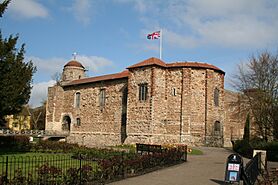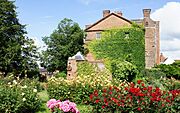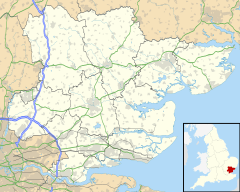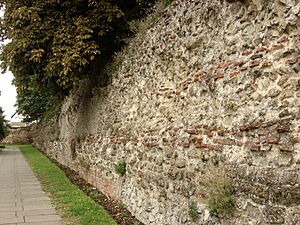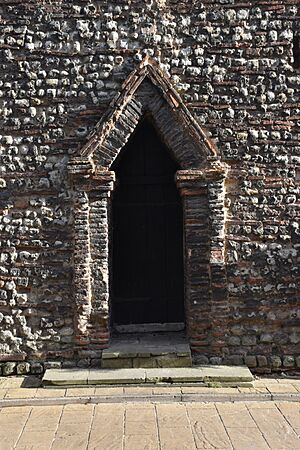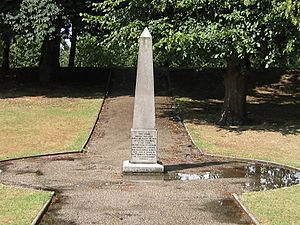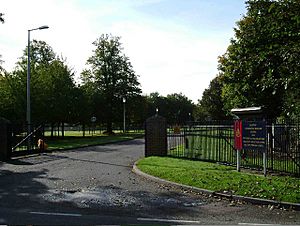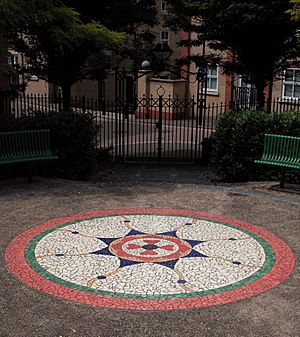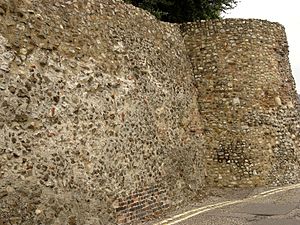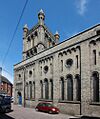Colchester facts for kids
Quick facts for kids Colchester |
|
|---|---|
| City | |
|
|
|
| Population | 130,245 (2021 Census) |
| Founded | 1st century BC |
| OS grid reference | TL998254 |
| • London | 56 mi (90 km) SW |
| District |
|
| Shire county | |
| Region | |
| Country | England |
| Sovereign state | United Kingdom |
| Post town | COLCHESTER |
| Postcode district | CO1–4 |
| Dialling code | 01206 |
| Police | Essex |
| Fire | Essex |
| Ambulance | East of England |
| EU Parliament | East of England |
| UK Parliament |
|
Colchester is a city in northeastern Essex, England. It is the second-largest town in the county. In 2021, about 130,245 people lived there. People from Colchester are called Colcestrians.
Colchester is built on the site of Camulodunum. This was the first major city in Roman Britain and its first capital. Because of this, Colchester claims to be Britain's first city. It has been an important military base since the Roman era. Today, the Colchester Garrison is home to the 16th Air Assault Brigade.
The city is located on the River Colne. It is about 50 miles (80 km) northeast of London. You can reach London by the A12 road or by train on the Great Eastern Main Line. Colchester is also close to London Stansted Airport and the port of Harwich.
Many interesting places are in and around the city. These include St Botolph's Priory, Colchester Zoo, and several art galleries. Colchester Castle was built in the 11th century on old Roman foundations. It is now a museum. The main campus of the University of Essex is between Colchester and Wivenhoe. The local government is run by the City of Colchester and Essex County Council.
Contents
What's in a Name?
There are different ideas about where the name Colchester comes from. Some people think it comes from two Latin words: colonia and castra.
- Colonia was a type of Roman settlement. People living there had similar rights to Roman citizens.
- Castra means fortifications or fort. This likely refers to the city walls, which are the oldest in Britain.
The earliest forms of the name, like Colenceaster, appeared in the 10th century. The modern spelling, Colchester, was first used in the 15th century. Some believe the River Colne also got its name from Colonia.
Other experts think the River Colne's name is older than the Romans. They believe Colchester comes from Colne and Castra. This is because other rivers in Britain are also called Colne or Clun. The idea that Colchester is linked to the legendary King Coel is not supported by history.
Colchester's Long History
Ancient Times
The hill where Colchester stands was formed a very long time ago. Scientists have found Stone Age tools, like Acheulian handaxes, in the area. These tools were made by early humans. Later, hunter gatherers lived in the Colne Valley. They also left behind flint tools.
Archaeologists have found many pieces of pottery from the Neolithic, Bronze Age, and early Iron Age. This shows that people lived here for thousands of years. There are also ancient monuments nearby. These include a henge (a circular earthwork) and large burial mounds from the Bronze Age.
Celtic Beginnings
Colchester is known as the oldest recorded town in Britain. This is because it was mentioned by a Roman writer named Pliny the Elder in AD 79. The Celtic name of the town was Camulodunon. This name appeared on coins made by a tribal leader called Tasciovanus around 20-10 BC.
Before the Romans arrived, Camulodunon was a powerful center for Cunobelin. He was a king of the Catuvellauni tribe, known as Cymbeline in Shakespeare's plays. His coins show the name Camulodunon, which means 'the fortress of [the war god] Camulos'. In the AD 30s, Cunobelin controlled a large part of Southern and Eastern Britain. Roman writers even called him "King of the Britons." Some people think Camulodunon might be one of the places linked to the legendary Camelot of King Arthur.
Roman Era
After the Roman conquest of Britain in AD 43, the Romans built a military fortress here. It was the first one in Britain. Later, around AD 49, the fortress became a Roman city called Colonia Victricensis. This city had a huge Temple to the Divine Claudius. It was the biggest classical-style temple in Britain. There were also other Roman temples.
Colchester is home to two of the five Roman theatres found in Britain. The one at Gosbecks is the largest in Britain and could seat 5,000 people.
Camulodunum was the Roman capital of Britain for a while. But in AD 61, it was attacked and destroyed during Boudica's rebellion. After this, London became the capital. Colchester's city walls, about 3,000 yards (2.7 km) long, were built around AD 65–80. This happened when the Roman town was rebuilt after Boudica's attack.
In 2004, archaeologists found the remains of a Roman Circus (a chariot race track) under the Garrison. This was a very rare find in Britain. The city was at its busiest in the 2nd and 3rd centuries AD. It might have had a population of 30,000 people then. In 2014, a collection of Roman jewelry, called The Fenwick Hoard, was found. Experts called it "one of the finest ever uncovered in Britain."
Saxon Period
After the Romans left, Colchester's defenses were quickly rebuilt around AD 268–282. Later, in the 4th century, the Balkerne Gate was blocked. Some historians believe the name Camelot from Arthurian legends might refer to Camulodunum.
Archaeologists have found some early Anglo-Saxon homes in Colchester. But it's not clear if Colchester continued as a proper town after the 6th century. The town's revival is not fully known. However, a 9th-century book called Historia Brittonum listed Colchester as one of the 30 most important cities in Britain.
Colchester was part of the Danelaw (an area ruled by Vikings) around 880 AD. It stayed in Danish hands until 917. Then, the army of Edward the Elder attacked and recaptured it. The Saxons in the 10th century called the town Colneceastre. The tower of Holy Trinity Church is from the late Saxon period.
Medieval and Tudor Times
Colchester's main landmark from the Middle Ages is Colchester Castle. It's an 11th-century Norman castle built on top of the old Roman temple. There are also other important medieval ruins. These include the gate of St John the Baptist abbey and the ruins of St Botolph's Priory. Many of Colchester's churches also date from this time.
In 1189, King Richard I (Richard the Lionheart) gave Colchester its first known royal charter. This gave Colchester's citizens the right to elect their own leaders. The town celebrated the 800th anniversary of this charter in 1989.
Colchester grew quickly in the late 14th century. It became a center for making woollen cloth. The town was famous in Europe for its "russets" (grey-brown fabrics). This helped the population recover fast after the Black Death. Many people moved to the town. By 1524, Colchester was the twelfth wealthiest town in England.
Between 1550 and 1600, many weavers and clothmakers from Flanders (now Belgium) moved to Colchester. They were known for making "Bays and Says" cloths. These were woven from wool. An area in Colchester town center is still called the Dutch Quarter. Many buildings there are from the Tudor period. Colchester was one of the most successful wool towns in England then. It was also famous for its oysters.
During the reign of "Bloody Mary" (1553–1558), Colchester became a place where Protestants were punished. At least 19 local people were burned at the stake near the castle. A tablet in St Peter's Church remembers them.
17th and 18th Centuries
In 1648, during the Second English Civil War, a Royalist army entered Colchester. A Parliamentary army, led by Thomas Fairfax, surrounded the town for over eleven weeks. This was called the Siege of Colchester. It began on June 13th. The Royalists gave up on August 27th. Charles Lucas and George Lisle were executed in the grounds of Colchester Castle. A small stone tower marks the spot where they died.
Daniel Defoe wrote that Colchester lost 5,259 people to the plague in 1665. This was more than many other towns.
Between 1797 and 1815, Colchester was a major army base. It had up to 6,000 soldiers. It played a key role in defending against a possible French invasion.
Victorian Era
Important Victorian buildings include Colchester Town Hall, the Jumbo Water Tower, and the Albert Hall.
In 1884, a strong earthquake hit the area. It caused a lot of damage.
The Paxman diesels company started in Colchester in 1865. Since the 1930s, Paxman has mainly made diesel engines.
20th Century and Beyond
In the early 1900s, Colchester wanted to be the main city for a new Church of England area called a diocese. But Chelmsford was chosen instead.
During World War II, Colchester was important for training soldiers. The Paxman factory also made many engines for British submarines. German planes sometimes bombed the town. In 1942, a raid hit Severalls Hospital and killed 38 patients. In 1944, a fire in the St Botolph's area destroyed many buildings. In total, 55 people died from bombing in Colchester during the war.
The University of Essex was built in Wivenhoe Park in 1961. A new bypass road, the A120, opened in 1982.
Colchester is growing quickly. Many new homes are being built. In 2011, Colchester and its surrounding area had a population of 121,859. The local football team, Colchester United, moved to a new stadium in 2008.
On May 20, 2022, it was announced that Colchester would become a city. This was part of the Platinum Jubilee Civic Honours for Queen Elizabeth II. Colchester officially received city status on September 5, 2022. King Charles III visited Colchester on March 7, 2023, to celebrate this.
Weather in Colchester
| Climate data for Colchester | |||||||||||||
|---|---|---|---|---|---|---|---|---|---|---|---|---|---|
| Month | Jan | Feb | Mar | Apr | May | Jun | Jul | Aug | Sep | Oct | Nov | Dec | Year |
| Mean daily maximum °C (°F) | 7 (45) |
7.7 (45.9) |
10.9 (51.6) |
14.2 (57.6) |
18 (64) |
20.6 (69.1) |
23.4 (74.1) |
23.3 (73.9) |
19.9 (67.8) |
15 (59) |
10.3 (50.5) |
7.4 (45.3) |
14.8 (58.7) |
| Daily mean °C (°F) | 4.5 (40.1) |
4.7 (40.5) |
7.1 (44.8) |
10.9 (51.6) |
12.8 (55.0) |
15.6 (60.1) |
18.3 (64.9) |
18.1 (64.6) |
15.4 (59.7) |
11.5 (52.7) |
7.5 (45.5) |
5 (41) |
11.0 (51.7) |
| Mean daily minimum °C (°F) | 2 (36) |
1.7 (35.1) |
3.3 (37.9) |
4.7 (40.5) |
7.7 (45.9) |
10.7 (51.3) |
13.2 (55.8) |
13 (55) |
10.9 (51.6) |
8.1 (46.6) |
4.8 (40.6) |
2.7 (36.9) |
6.9 (44.4) |
| Average precipitation mm (inches) | 53 (2.1) |
44 (1.7) |
44 (1.7) |
44 (1.7) |
52 (2.0) |
54 (2.1) |
48 (1.9) |
57 (2.2) |
52 (2.0) |
70 (2.8) |
62 (2.4) |
57 (2.2) |
637 (24.8) |
| Source: 1981–2010 estimated average (records began in 1988) for COL station Colchester NE 2 | |||||||||||||
Colchester is in one of the driest parts of the United Kingdom. It gets about 635 mm (25 inches) of rain each year. This is less than many other places in the UK. Colchester has an Oceanic climate, like the rest of the UK.
Because it's in the east, Colchester is less affected by Atlantic storms. This means it has a drier climate. It can also have more extreme temperatures. Summers can be hot, sometimes reaching over 30°C (86°F). Winters can have nights below freezing. Snow falls about 13 days a year.
The hottest temperature ever recorded in Colchester was 36.1°C (97°F) in August 2003. The coldest was -9.4°C (15°F) in December 2010.
Colchester Garrison
Colchester has been an important military base since Roman times. The Colchester Garrison is now home to the 16th Air Assault Brigade. The Army's only military training center for soldiers who need to improve their discipline is in Colchester. It's sometimes called "The Glasshouse".
From 1998 to 2008, the army area was greatly redeveloped. Some land was sold for homes, and parts of the garrison moved.
Since 2006, Colchester has been one of 12 places in the UK where Royal Salutes are fired. These mark special Royal events. Since 2009, these salutes have taken place in Castle Park.
BFBS Radio broadcasts from studios on the base. You can listen to it on 107.0FM.
How Colchester is Governed
The Colchester City Council is in charge of local government.
The Member of Parliament (MP) for Colchester is Pam Cox from the Labour Party. The former MP, Sir Bob Russell, has a special role as High Steward of Colchester since 2015.
Culture and Fun
Museums
Colchester has several museums. The Castle Museum is inside Colchester Castle. It has many exhibits about Roman Colchester. Nearby, Hollytrees Museum shows social history and has exhibits for children. The Natural History Museum is in the old All Saints' Church.
The Colchester Archaeological Trust has a visitor center and museum. It displays finds from the Roman Circus. You can see models of the circus and items from Roman cemeteries. In 2014, parts of a large Roman temple were found behind the High Street. There are plans to make them visible to the public.
Arts and Entertainment
The Mercury Theatre opened in 1972. It is a repertory theatre. Close by is Colchester Arts Centre. This is a multi-purpose arts venue in the old St Mary-at-the-Walls church. It also hosts the Colchester Beer Festival. The Headgate Theatre is another theatre in Colchester.
Firstsite is a modern art organization. It is based in the Visual Arts Facility, which opened in 2011.
The Minories has art galleries managed by Colchester Institute. They show modern art by local artists.
There are also several bars with live music. In 2009, an art group called 'Slack Space' turned empty shops into art galleries. The Colchester School of Art, which opened in 1885, is part of the Colchester Institute.
Colchester has 12 cinema screens. These are at the Odeon, Curzon, and Firstsite gallery.
Sports
Colchester has a long history with football. The amateur club Colchester Town was formed in 1867. The professional club, Colchester United, started in 1937. They play in Football League Two and their home games are at Colchester Community Stadium. In 2006–07, they reached their highest league finish.
Other sports teams in the area include:
- Colchester United Women Football Club
- Colchester School of Gymnastics
- Colchester Rugby Football Club
- Colchester Swimming Club
- Colchester Gladiators American Football Club
- Colchester Weight Lifting Club
- Colchester Powerlifting Club (ColPower)
- Colchester & East Essex Cricket Club
Essex County Cricket Club plays some games at Castle Park Cricket Ground. Sports facilities include Colchester Leisure World and the Colchester Garrison Athletics Stadium. There is also a skatepark.
Media
Local news and TV shows come from BBC East and ITV Anglia. Colchester's local radio stations are BBC Essex (103.5 FM), Heart East (96.1 FM), Greatest Hits Radio East (100.2 FM), and Actual Radio (online). Local newspapers include the Colchester Gazette, Essex County Standard, and East Anglian Daily Times.
Shopping
The town center has many shops. These include large department stores like Fenwick and popular chains like Primark and H&M. There are also many local independent stores.
Famous Landmarks
Colchester War Memorial
Colchester lost about 1,248 people in the First World War. People wanted a memorial to remember them. In 1919, the sculptor Henry Charles Fehr was chosen to create it. He was paid £3,000. The memorial has three human figures on a stone base. These figures represent Saint George, peace, and the goddess Nike.
Roman Walls
The walls of Colchester were built between AD 65 and 80. This was after the city was destroyed by Boudicca. The walls were used until the Siege of Colchester in 1648. Two large parts of the wall are still standing on the west and north sides. Many smaller pieces can be seen along the rest of the wall's path.
A very important part that still stands is the Balkerne Gate. It is the oldest and most complete Roman gateway in the United Kingdom. You can walk a path of almost 2 miles (3 km) that follows the old wall.
"Jumbo" Water Tower

This water tower was finished in 1883. It was first called the "Balkerne Water Tower." But soon, people started calling it "Jumbo" because of its huge size. An elephant-shaped weather vane was added to its top. The tower stopped being used in 1987. It has had several private owners since then.
Colchester Town Hall
The current town hall was built on the site of an older building. Work on the new building started in 1897. It was designed by John Belcher in the Edwardian Baroque style. The building opened in 1902. It was opened by a former prime minister, the Earl of Rosebery.
The building stands out on the High Street. Its Victoria Tower is 192 feet (58.5 meters) tall and can be seen from far away. The tower was built to celebrate the Diamond Jubilee of Queen Victoria. It was paid for by a donation from James Noah Paxman. The tower has four figures representing engineering, military defense, farming, and fishing. At the very top is a large bronze figure of Saint Helena. She is the patron saint of Colchester.
Learning in Colchester
Secondary Schools
Colchester has a two-tier school system. Two of the secondary schools, Colchester Royal Grammar School and Colchester County High School for Girls, select students based on exams. Other secondary schools are comprehensives. These include The Gilberd School, Colchester Academy, Philip Morant School and College, St Helena School, St Benedict's Catholic College, Thomas Lord Audley School, Paxman Academy, and Trinity School.
Private Schools
Private schools in Colchester are St. Mary's School, Oxford House School, and Colchester High School.
Higher Education
The University of Essex is located east of Colchester in Wivenhoe Park. Other places for higher education are Colchester Sixth Form College and Colchester Institute. Colchester also has an ACL center.
Getting Around Colchester
Buses
Bus services in Colchester are mainly run by First Essex and Arriva Colchester. Other companies also operate buses. The bus station is on Osborne Street. Key routes go to Chelmsford and Clacton-on-Sea.
Trains
Colchester Town and Hythe stations are on the Sunshine Coast Line. They connect to the wider train network at Colchester North station.
Roads
Colchester is connected to London and East Anglia by the A12. This road goes around the town. The A120 connects Colchester to Harwich in the east and Stansted Airport in the west.
Port
Colchester used to be a busy port. By 1637, ships sailed weekly to London. In 1892, about 3,000 ships used the port each year. The old quay at The Hythe is no longer used because the river has become too shallow. However, Colchester is still a registered port.
Famous People from Colchester
Many notable people have lived in Colchester, including:
- Cunobelin (died before 43 AD), a powerful Celtic king.
- Damon Albarn (Born 1968), lead singer of the bands Blur and Gorillaz.
- William Gilbert (1544–1603), a scientist who studied magnetism.
- Jane Taylor (1783–1824), who wrote the words to "Twinkle, Twinkle, Little Star".
- William Gull (1816–1890), a doctor to Queen Victoria.
- Charles Spurgeon (1834–1892), a famous preacher.
- Margaret Thatcher (1925–2013), a former Prime Minister.
- Roger Penrose (born 1931), a mathematical physicist.
- Graham Coxon (born 1969), lead guitarist for Blur.
- Ali Carter (born 1979), a professional snooker player.
- Sam Pilgrim (born 1990), a freeride mountain biker.
Twin Towns
Colchester has special friendships with other towns around the world. These are called twin towns:
- Wetzlar, Germany, since 1969
- Avignon, France, since 1972
- Imola, Italy, since 1997
- Yangzhou, China, since 2015
Images for kids
See also
 In Spanish: Colchester para niños
In Spanish: Colchester para niños


